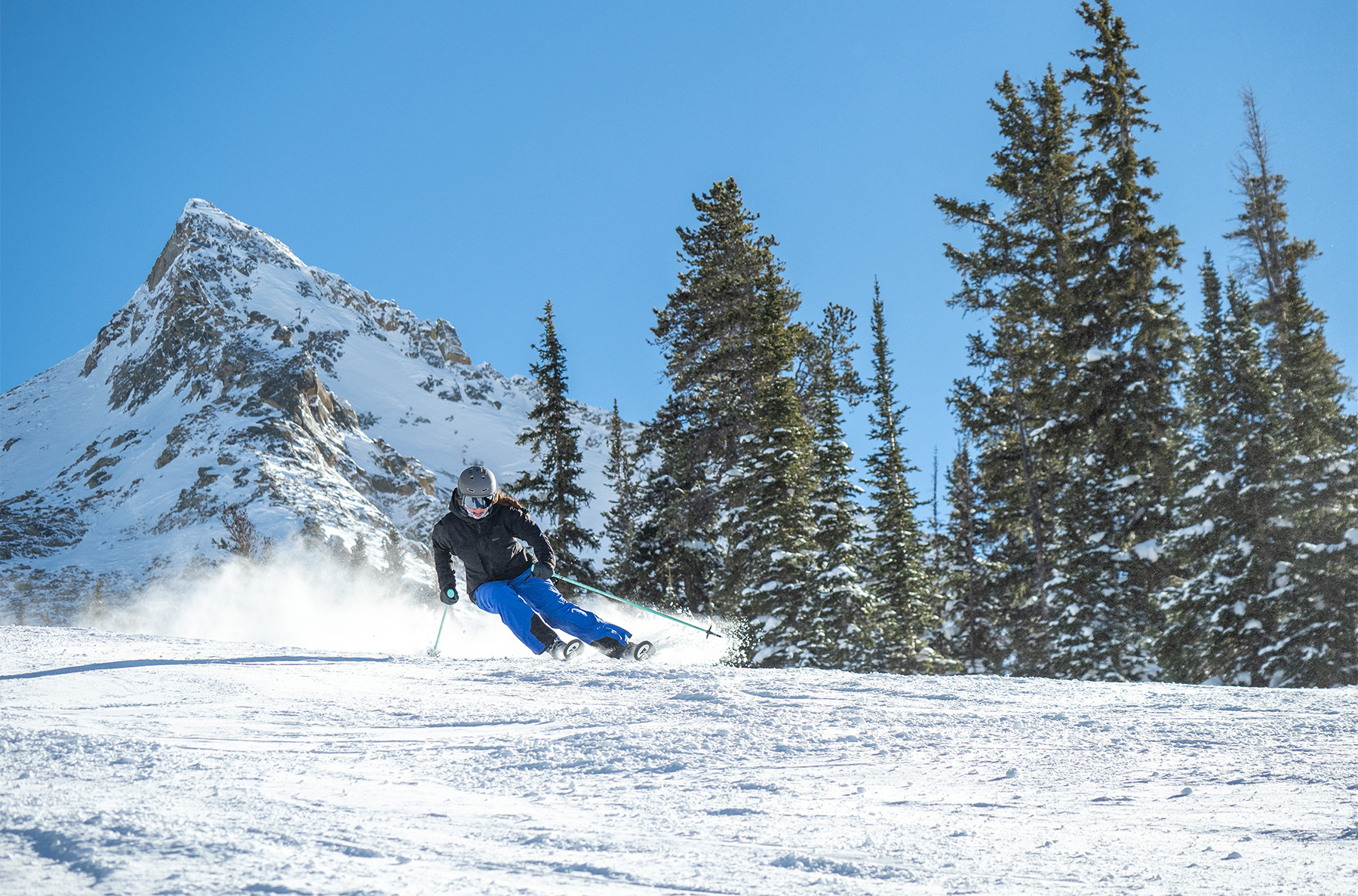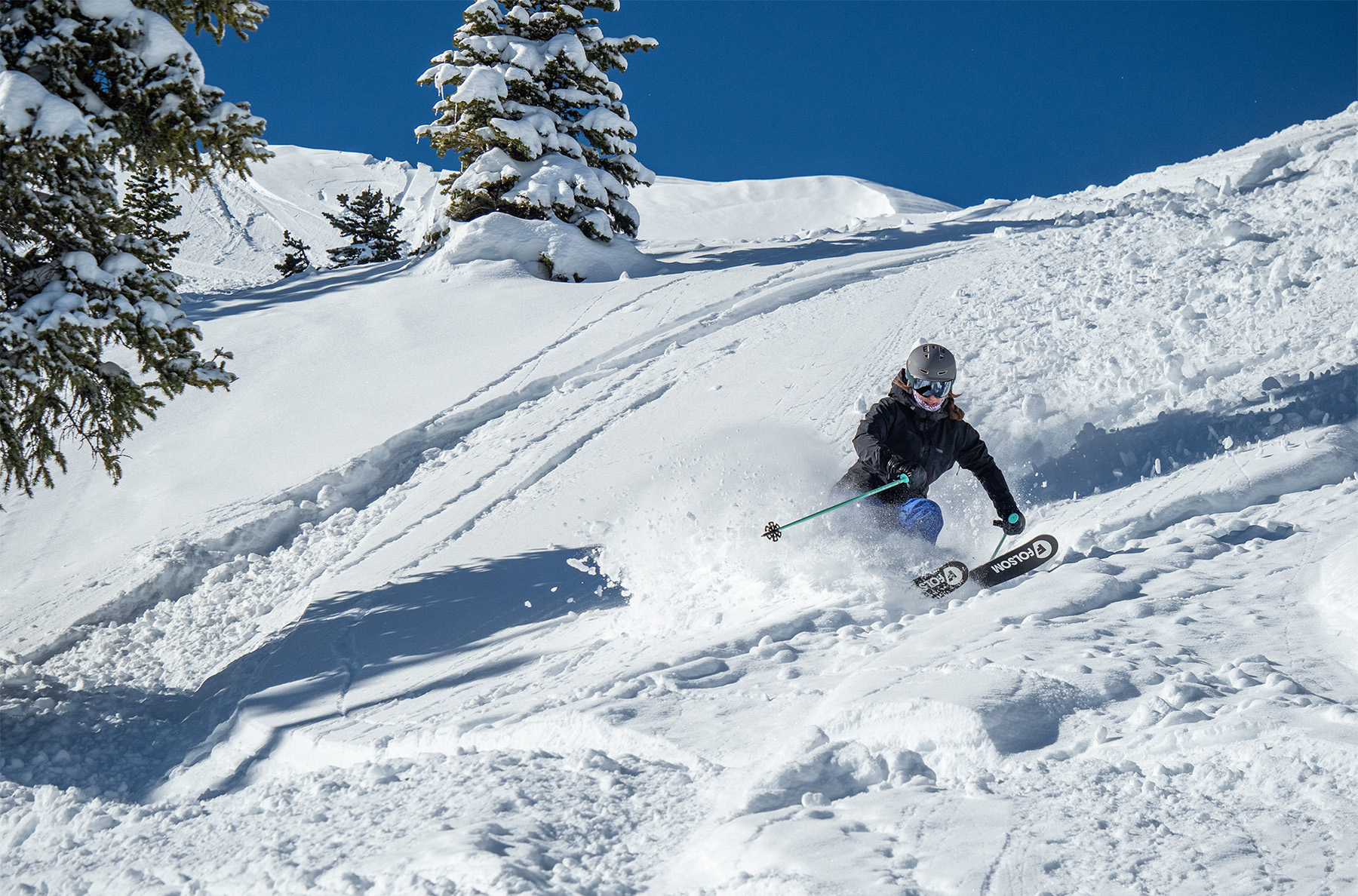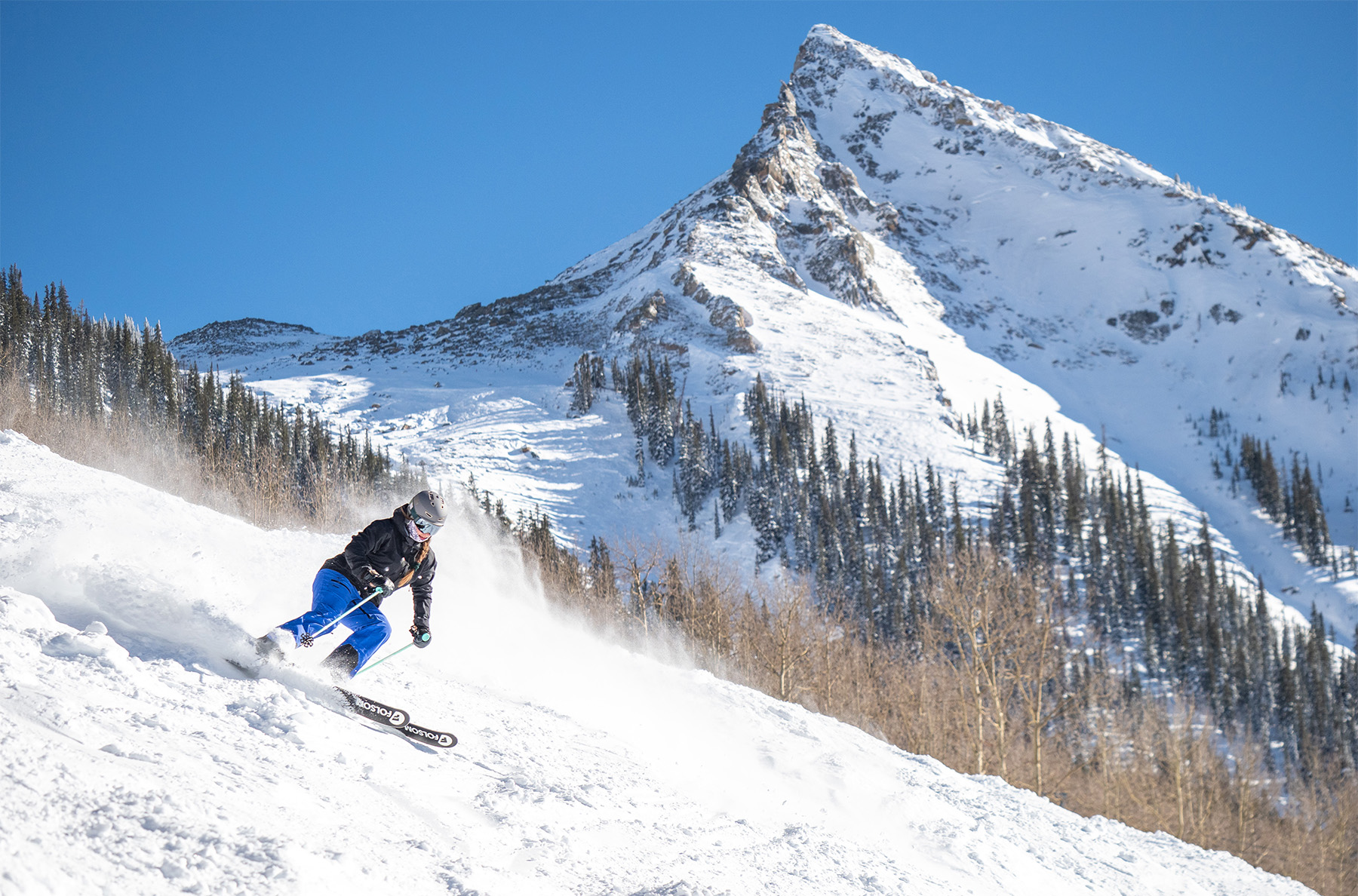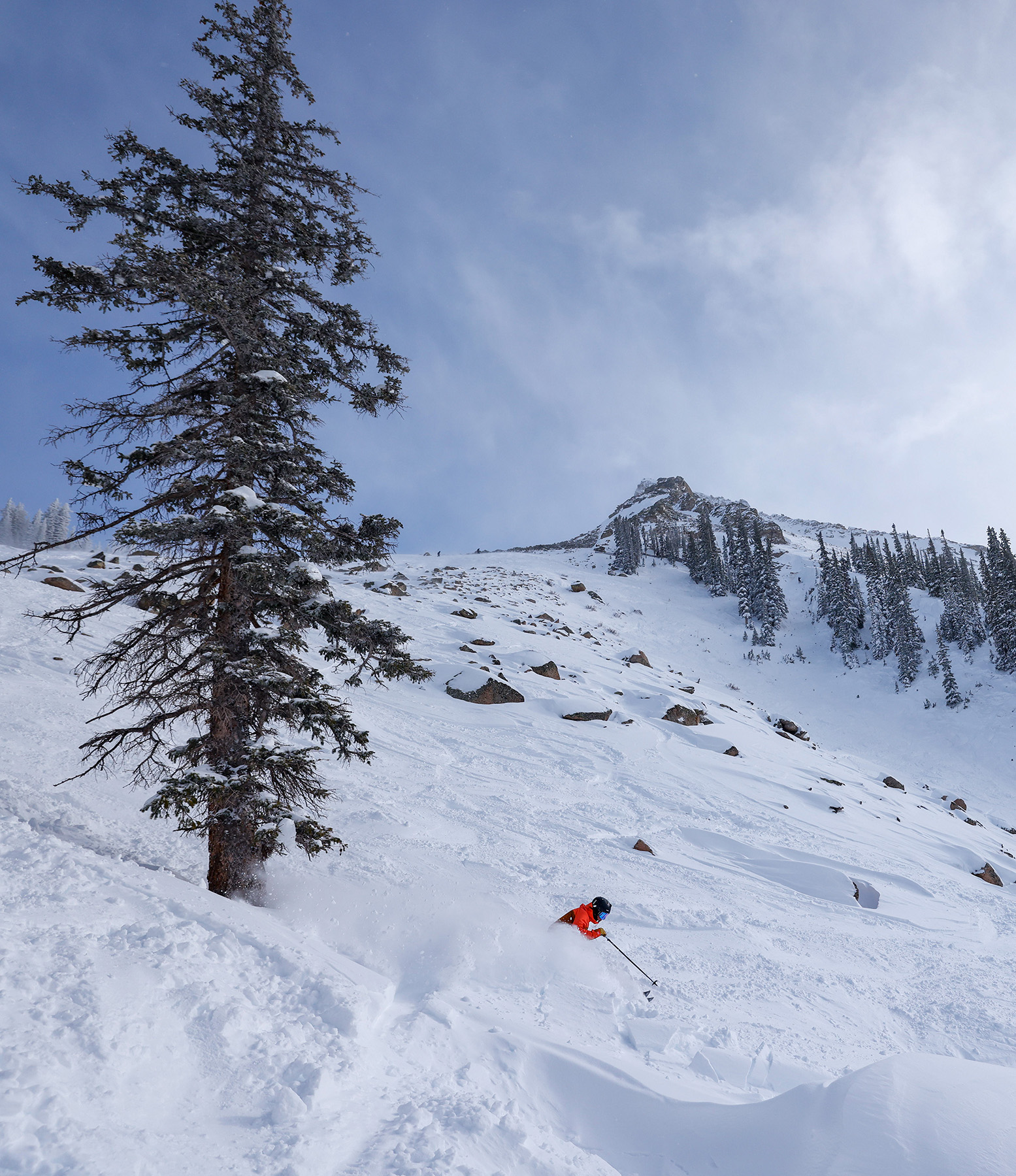Ski: 2022-2023 Folsom Cash 106, 176 cm
Available Lengths: 164, 169, 174, 179, 184, 189 cm (custom available)
Blister’s Measured Tip-to-Tail Length (straight-tape pull): 174.4 cm
Blister’s Measured Weight per Ski: 1884 & 1894 grams
Stated Dimensions: 138-106-124 mm
Blister’s Measured Dimensions: 138-104.6-124 mm
Stated Sidecut Radius (176 cm): 18 meters
Measured Tip & Tail Splay (ski decambered): 61 mm / 36.5 mm
Measured Traditional Camber Underfoot: 5 mm
Core Materials: poplar/bamboo + fiberglass & carbon laminate
Base: sintered
Factory Recommended Mount Point: -6.7 cm from center; 80.5 cm from tail
Ski: 2022-2023 Folsom Cash 106, 188 cm
Blister’s Measured Tip-to-Tail Length (straight-tape pull): 185.5 cm
Blister’s Measured Weight per Ski: 1989 & 2000 grams
Stated Dimensions: 138-106-124
Blister’s Measured Dimensions: 138-105-124 mm
Stated Sidecut Radius (176 cm): 21 meters
Measured Tip & Tail Splay (ski decambered): 73 mm / 32 mm
Measured Traditional Camber Underfoot: 4 mm
Factory Recommended Mount Point: -8 cm from center; 84.5 cm from tail
Test Location: Mt. Crested Butte, Colorado
Days Skied: 9
Boots / Bindings: Tecnica Cochise Pro W, Tecnica Mach1 MV 130, Fischer Ranger 115 W / Tyrolia Attack 14

Intro
We’ve spent time on a few different versions of Folsom’s Cash 106 shape over the years, first with their older-generation carbon touring layup, then with a few of their heavier resort builds at past years’ Blister Summits, and most recently, on two lengths with a moderately lightweight build that falls somewhere in the middle.
(Given that Folsom makes their skis custom to order in Colorado, they could tweak the ski to your preferences; more on that later.)
For a backstory on how Folsom does things, you can check out our previous Blister Summit Brand Lineup video with their founder, Mike McCabe:
What Folsom says about the Cash 106
“A User Friendly All Mountain Ski:
- 106mm underfoot across a multitude of lengths creates a one-ski-quiver for intermediate to advanced skiers
- Recommended Directional Rocker profile makes an excellent build with superior energy transmission through the ski for the traditional skier
- Shorter turning radius across all lengths keeps the Cash playful and reactive”
Construction
The particular Cash 106s we’re discussing here were built with Folsom’s lighter “Resort” construction, which includes a poplar / bamboo wood core, 90% fiberglass / 10% carbon laminate, and a sintered base.
Alternatively, you could get a Cash 106 (or any Folsom ski, for that matter), with a range of material combinations, including heavier or lighter wood cores and composite combinations, depending on your priorities.
Shape
This is the one thing that stays consistent across custom Cash 106 builds — the shape. It features some early tapering at the tips, slightly less at the tail, and generally looks like a pretty typical, modern, ~106mm-wide all-mountain ski.
Rocker Profile
The Cash 106 discussed here features what Folsom calls their “Directional Rocker” profile, but the ski can also be built with their “Everyday Rocker” profile, which features significantly more splay in both tip and tail, but especially in the tail.
With the Directional Rocker profile, the Cash 106 has a fairly deep tip rocker line, a notable amount of tip splay, and a less rockered, less splayed-out tail. That’s all combined with a cambered section that makes up most of the length of the ski.
Flex Pattern
Here’s how we’d characterize the flex pattern of the 176 cm Cash 106:
Tips: 6.5-7
Shovels: 7-7.5
In Front of Toe Piece: 8-10
Underfoot: 10
Behind the Heel Piece: 9.5-8.5
Tails: 8-7
Here’s how we’d characterize the flex pattern of the 188 cm Cash 106:
Tips: 7
Shovels: 7.5-8.5
In Front of Toe Piece: 9-10
Underfoot: 10
Behind the Heel Piece: 9.5-8.5
Tails: 8-7
Folsom calls the flex patterns for these two pairs of the Cash 106 “Standard,” and that makes sense — there’s nothing really out of the ordinary going on with either of them. They’re quite stiff through the cambered portion (a bit less so with the shorter 176 cm), but with tips and tails that are notably softer (though maybe a touch stiffer than average for this class).
Sidecut Radius
The stated sidecut radius of the Cash 106 varies a bit across lengths, from 15 meters for the 164 cm length to 21 meters for the 189 cm length. On that note about length:
Available Lengths
Folsom lists six available lengths for the Cash 106 shape on their site, but they also told us “we’re fully capable of making that Cash 106 in literally every centimeter length between 160 cm and 190 cm.”
So our thoughts on the 176 cm and 188 cm Cash 106 we’ve been skiing should be most applicable to the standard 174 cm and 189 cm lengths, respectively, but you can fine-tune length with Folsom.
Mount Point
The 176 cm Cash 106 we have has a recommended mount point of about -6.7 cm from true center, while the 188 cm length’s recommended mount point is -8 cm from true center. Both of those are a touch closer to center than some traditional, directional skis, but not as close to center as freestyle-specific skis.
Weight
The versions of the Cash 106 discussed here are a bit lighter than average compared to all ~106mm-wide skis on the market (and noticeably lighter than the heavier versions we skied at the Blister Summit), but they’ve got plenty of close company when it comes to weight.
For reference, here are a number of our measured weights (per ski in grams) for some notable skis. Keep in mind the length differences to try to keep things apples-to-apples.
1761 & 1778 Zag Slap 104, 176 cm (21/22-22/23)
1800 & 1804 Head Kore 105, 184 cm (21/22)
1818 & 1823 Folsom Cash Carbon, 184 cm (20/21)
1820 & 1821 Majesty Havoc Carbon, 186 cm (20/21–22/23)
1836 & 1838 Armada ARW 106 UL, 180 cm (21/22-22/23)
1847 & 1854 Wagner Summit 106, 172 cm (21/22-22/23)
1875 & 1881 Line Sir Francis Bacon, 184 cm (19/20–22/23)
1878 & 1891 Salomon QST Stella 106, 173 cm (22/23)
1880 & 1916 Fischer Ranger 102, 176 cm (22/23)
1884 & 1984 Folsom Cash 106, 176 cm (22/23)
1905 & 1919 J Skis Slacker, 188 cm (20/21–21/22)
1920 & 2006 RMU North Shore YLE 110, 186 cm (21/22–22/23)
1946 & 1962 Black Crows Atris, 184 cm (22/23)
1947 & 2011 4FRNT Devastator, 186 cm (20/21–22/23)
1951 & 1953 Elan Ripstick 106, 188 cm (20/21–22/23)
1951 & 1957 RMU Apostle 3.0 106, 184 cm (21/22–22/23)
1958 & 1960 Faction Dancer 3X, 172 cm (22/23)
1970 & 1993 Moment Deathwish 104, 184 cm (21/22–22/23)
1989 & 2000 Folsom Cash 106, 188 cm (22/23)
1997 & 2001 Zag Slap 104, 188 cm (21/22-22/23)
2008 & 2065 Wagner Summit 106, 186 cm (20/21–22/23)
2009 & 2010 Rossignol Sender 104 Ti, 186 cm (22/23)
2011 & 2028 Moment Wildcat 108, 184 cm (19/20–20/21)
2011 & 2046 Elan Ripstick 106 Black Edition, 188 cm (21/22–22/23)
2022 & 2046 DPS Foundation Koala 103, 184 cm (21/22–22/23)
2046 & 2120 Black Crows Corvus, 188 cm (18/19–22/23)
2057 & 2061 Fischer Ranger 102, 183 cm (22/23)
2073 & 2074 Season Nexus, 183 cm (20/21–22/23)
2074 & 2088 Line Blade Optic 104, 178 cm (22/23)
2110 & 2117 Fischer Ranger 108, 185 cm (22/23)
2110 & 2119 Moment Wildcat 108, 190 cm (19/20–20/21)
2112 & 2125 4FRNT MSP 107, 187 cm (18/19–22/23)
2068 & 2178 Salomon QST 106, 181 cm (22/23)
2120 & 2134 Blizzard Rustler 10, 188 cm (19/20–22/23)
2138 & 2172 Rossignol Sender 106 Ti+, 187 cm (22/23)
2145 & 2167 Sego Big Horn 106, 187 cm (20/21–21/22)
2165 & 2219 Icelantic Nomad 105, 191 cm (19/20–20/21)
2170 & 2180 Dynastar M-Free 108, 182 cm (20/21–22/23)
2177 & 2178 Moment Commander 108, 182 cm (20/21–22/23)
2220 & 2237 K2 Mindbender 108Ti, 186 cm (22/23)
2232 & 2242 Blizzard Cochise 106, 185 cm (20/21–22/23)
2230 & 2290 Line Blade Optic 104, 185 cm (22/23)
2295 & 2344 J Skis Hotshot, 183 cm (20/21–22/23)
2302 & 2342 Dynastar M-Free 108, 192 cm (20/21–22/23)
2312 & 2386 Prior Husume, 188 cm (17/18–22/23)
2353 & 2360 Volkl Katana 108, 184 cm (20/21–22/23)
2449 & 2493 J Skis Hotshot, 189 cm (20/21–22/23)
Now, onto how all of this translates on snow:
FULL REVIEW
Kara Williard (5’9”, 167 lbs / 175 cm, 75.7 kg): I first skied the heavy-build version of the Cash 106 at the Blister Summit last year in some pretty deep snow. While it offered impressive suspension and had a real knack for charging through powder and crud, I found it a little difficult when negotiating tight terrain or less confidence-inspiring conditions. Given that, I was really curious to see how a slightly lighter version would compare in terms of both high-speed stability and low-speed maneuverability.
Luke Koppa (5’8”, 155 lbs / 173 cm, 70 kg): I didn’t ski the heavy Cash 106 at the Blister Summit, but I have skied an older, lighter, touring-oriented version, so I also had some context coming into this review. Like Kara, I was very curious to see how this more middle-of-the-road build of the Cash 106 would compare to the latest crop of ~106mm-wide all-mountain skis.

Groomers
Kara: This version of the 176 cm Folsom Cash 106 is an impressive ski on groomers for its width and stands out as a ski that gives back what you put into it, in that, the more you pressure and drive it, the more energetic and precise it feels. The Cash 106 is relatively easy to tip on edge and it feels pretty stable even at higher edge angles on firm snow.
Compared to my experience last year on the stiffer version, this version’s more forgiving flex pattern made it easier to bend into a carve and made for a more accessible ski that I am willing to push a bit harder on groomers.
Overall, I found the Cash 106 to balance maneuverability and edge hold quite nicely. Its groomer performance is pretty reminiscent of the Salomon QST Stella 106, but the QST Stella 106 is a touch looser and more maneuverable. While it’s not the most stable or precise ski in its class (which was most apparent on icier patches) I found the Cash 106 unexpectedly fun to carve.

Luke: I’d mostly describe the Cash 106 as “predictable” on piste. There are several other skis around this width that are quicker / easier when it comes to turn initiation, and several that offer better edge hold on scraped-off patches. But for a ~105mm-wide ski, the Cash 106 does just fine on piste, and on somewhat forgiving groomer conditions (e.g., fresh corduroy), I found myself confidently laying it over into pretty aggressive turns. At the same time, it makes it very easy to feather and release the tail when needed. So it’s not the ski in this class I’d choose if overall on-piste performance was a big priority, but it by no means feels handicapped by a lack of precision or composure on groomed slopes.
Soft Chop & Powder
Kara: Soft chop and powder were really enjoyable on the Cash 106; it provided a stable ride without being very sluggish. The Cash 106 is pretty loose and playful, but combined with its smooth and intuitive flex pattern, I still found the ski quite willing to plow through chop. While it lends itself to a fast and committed skiing style, I also found that the Cash 106 felt fine when slowing it down and making smaller turns.
Compared to skis such as the Fischer Ranger 102 and ZAG Slap 104, the Cash 106 is comparable in terms of maneuverability but provides far better suspension and composure in chopped-up snow. Across all applications, the Cash 106 felt most intuitive when in a forward stance, and particularly in deep or choppy snow, this helped keep the shovels from getting knocked around while still avoiding any unpredictable diving when hitting varying densities of snow.

Luke: Yep, the Cash 106 is a ton of fun in fresh snow and freshly chopped-up snow. It is a pretty loose and maneuverable ski, but relative to many similarly surfy skis, this Cash 106’s “standard” flex pattern feels a bit stronger, which allowed me to push it harder into cut-up piles of snow, without folding / getting hung up. And while its shape and rocker profile are far from radical, I thought it provided very impressive flotation for its width.
This build is still fairly light, so I had to keep my speed in check when hitting denser piles of chop, but I’d say its stability in softer chop is well above average, while still feeling pretty agile and maneuverable.
Firm Chop / Crud
Kara: In firm chop and crud, the Cash 106 did not disappoint. For its weight, I was quite impressed by how smooth and stable it felt in less-than-ideal snow. This version’s flex pattern, while fairly stiff and powerful, also felt quite intuitive and accessible to me. It feels like a pretty strong ski overall, but in a way that’s balanced and not too demanding. I could ski it pretty aggressively when I felt like it, but it wasn’t overly demanding or punishing when I was feeling subpar or the conditions were less than inspiring.
In this way, the 176 cm Cash 106 reminded me quite a bit of the 178 cm Line Blade Optic 104 and the 173 cm Salomon QST Stella 106 — capable of being pushed pretty hard in crud, but not very difficult when I need to shut down speed or make smaller, more controlled turns.
Luke: Agreed. This fairly light Cash 106 definitely isn’t super damp or composed in nasty snow, relative to the entire market of ~105mm-wide skis, but it handles admirably in these conditions. If I wanted to optimize performance in cruddy snow, I’d definitely go with Folsom’s heavier builds, but in this iteration, Folsom has made a pretty nimble, maneuverable ski that remains fairly intuitive in the conditions that often make skis that fit a similar description really struggle.
Moguls, Trees, & Tight Terrain
Kara: I preferred the Cash 106 in more open terrain where I could take advantage of its strong flex pattern and solid stability to make aggressive, down-the-fall-line turns, but it still felt quite reasonable and accessible in tight terrain. While there are skis that are looser, the Cash 106 feels both lively and balanced when making tight, quick turns, when terrain like this features anything from firm snow to tracked-out chop.

Similar to my experience with groomers, I found this slightly lighter, softer version to feel a little easier to bend into turns, which was a big plus in tight spots, relative to the heavier, stiffer version we skied last year. For someone who would rather maximize stability over maneuverability, the heavier version would likely be the better option. But I felt a little more confident in tighter terrain on this lighter build, and it’s definitely more accessible overall.
Luke: Yep. This 188 cm Cash 106 sits on the more nimble, more maneuverable end of the spectrum, but it doesn’t go as far to those extremes as some other similarly light skis in this class. This version kept me honest in terms of not spending a ton of time in the backseat, but it was considerably more forgiving of the occasional mistake than, say, the Folsom Blister Pro 104 (aka, a very stiff, very heavy Folsom Primary 104). This Cash 106 performs best when you’re biasing your weight toward its shovels, not its tails, but it’s far from some super demanding ski. And when pivoting / sliding turns between bumps, its tail did a good job of keeping from hooking up when I didn’t want it to.
Playfulness
Kara: This Cash 106 feels pretty middle-of-the-road when it comes to playfulness. It’s not built for the most playful skier looking for a balanced freestyle ski, and it’s certainly more stable and precise than a lot of more freestyle-oriented options. But with its low swing weight, fairly loose tail, and somewhat lively flex pattern, it feels far from some one-dimensional directional ski.
Luke: Yeah, this is definitely a directional ski and doesn’t strike me as super playful, but you could always opt for a slightly softer flex pattern and Folsom’s more tail-rockered “Everyday Rocker” profile for a more accessible and looser ride. As is, this Cash 106 feels like a pretty maneuverable and agile — but still quite directional — ski. It didn’t hold me back from attempting my usual, frequent straight airs, but I’d look elsewhere (or consider tweaking the build) if you wanted something really balanced, lively, and generally playful.
Mount Point
Kara: In my usual fashion, I stuck to the recommended mount point (-6.7 from center) for the 176 cm Cash Carbon 106. I generally ski with a pretty directional style and a forward stance, and the Cash 106 suited that just fine. I actually expected the mount point to be a bit further back after skiing it; as a directional skier, I got along great with it.
Luke: I stuck with the 188 cm Cash 106’s recommended mount point (-8 cm from true center) and it unsurprisingly felt very intuitive mounted there. If I were to make the theoretical tweaks mentioned in the “Playfulness” section, I’d probably also ask Folsom to move the mount point closer to -6 cm from true center for a more balanced feel, but I think the -8 cm mount point on this pair will work great for anyone who’d get along with the rest of the ski’s design.
Length
Kara: The 176 cm Cash 106 felt like a pretty ideal length for me (as someone who tends to ski anything from 170 to 180 cm, depending on the particular ski). Its overall maneuverability kept this length from feeling too cumbersome in bumps, but it was plenty stable and supportive on firm snow and chop. It’s also important to note that Folsom has the capability to make the Cash 106 in a wide range of sizes from 160-190 cm (in 1 cm increments), so you can easily find your perfect length somewhere in there.
I’d say there’s nothing major to note here, other than when I skied the heavier version, I skied it slightly longer in a 179 cm and it felt quite a bit more cumbersome and difficult to maneuver. If I were designing a version with that heavier, stiffer build, I’d probably opt to go a bit shorter.

Luke: The 188 cm Cash 106 felt great to me (I typically prefer skis in this class ranging from 182 cm to 192 cm). Given the huge range of factors you can tweak when designing a ski with Folsom, my personal ideal length would ultimately depend on how stiff, heavy, and rockered I went with the rest of the build. But for this Cash 106, it felt like it skied pretty true to length, neither feeling unusually long nor short.
Who’s It For?
Kara: There are many people that could potentially get along with this Cash 106, given all that the Cash 106 has to offer in terms of being a relatively lightweight ski that is also pretty stable and can be skied quite hard.
So, for clarification, here are a few skiers that this particular construction of the Cash 106 isn’t for. If you are looking for the most stable or plush ski to really smooth out firm or cruddy conditions, and you find yourself in these conditions quite a bit, a heavier ski will be a better choice. Or, if your skiing style borders the directional / freestyle ends of the spectrum, there are looser, more forgiving, more lively alternatives (though I believe this Cash 106 could still feel intuitive for those folks).
But it’s also reasonable to think that, by customizing the Cash 106 and moving in one direction more than the other (heavier or lighter, stiffer or softer, etc.), the Cash 106 could potentially work for these more niché ends of the spectrum as well.
Luke: This Cash 106 is already quite versatile — it does an impressive job of being more stable in chop than many similarly light skis, while still being notably more nimble and maneuverable than most heavier, more stable skis. That alone is worth commending, and then when you factor in the aspects of its construction that you can customize, it’s clear that the number of skiers it would not work for is far, far smaller than the number for which it would.
Bottom Line
The Folsom Cash 106 platform is inherently versatile — it blends above-average maneuverability in soft snow and off-piste terrain with very respectable stability and precision. The light-ish builds reviewed here are excellent choices for skiers who prefer something that’s on the more agile and maneuverable end of the spectrum, but that’s still got enough heft and backbone to be skied quite hard in fairly forgiving conditions. But considering how much Folsom can change about this ski to suit your preferences, the roles it could fill and the range of skiers it could make happy are quite impressive.
Deep Dive Comparisons
Become a Blister Member to check out our Deep Dive comparisons of the Cash 106 to see how it compares to the Folsom Primary 104, Salomon QST 106, Black Crows Atris, Line Blade Optic 104, Black Crows Corvus, Elan Ripstick 106, DPS Pagoda 106 C2, RMU Apostle 106, DPS Koala 103, Moment Deathwish 104, Rossignol Sender 104 Ti, Blizzard Rustler 10, 4FRNT Devastator, Whitedot Altum 104, 4FRNT MSP 107, Sego Big Horn 106, Nordica Enforcer 104 Free, Shaggy’s Ahmeek 105, J Skis Hotshot, Armada ARW 106 UL, & ZAG Slap 104.


